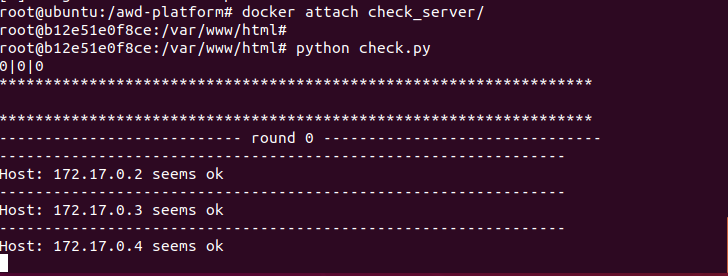线下AWD平台搭建以及一些相关问题解决
线下AWD平台搭建以及一些相关问题解决
0x01: 一.前言
文章首发于tools,因为发现了一些新问题但是没法改,所以在博客进行补充。
因为很多人可能没有机会参加线下的AWD比赛,导致缺乏这方面经验,比如我参加过五次线下AWD攻防,虽然看过许多网上的AWD打发套路,但终究都是纸上谈兵,所以前几次都是被吊锤,一来不熟悉环境,二来有点手忙脚乱,其实根本原因就是缺乏经验,因此最近翻了翻Github,终于找到一个不错的项目,下面便是搭建过程和一些注意事项。
0x02: 二、平台搭建过程:
准备工作:需要准备一台Ubuntu虚拟机,我的版本是16.04,过程比较详细,如果会这些的大佬挑重点看就行。
1.更新apt包索引
$ sudo apt-get update
2.安装git
$ sudo apt install git
3.安装docker
$ sudo apt-get install -y apt-transport-https ca-certificates curl software-properties-common
$ curl -fsSL https://download.docker.com/linux/ubuntu/gpg | sudo apt-key add -
$ sudo add-apt-repository "deb [arch=amd64] https://download.docker.com/linux/ubuntu$(lsb_release -cs) stable"
//查看可用的docker
$ sudo apt-cache madison docker-ce
[attach]79574[/attach]
//选择要安装的特定版本
$ sudo apt-get install docker-ce=<VERSION>
//比如我要安装 18.06.3~ce~3-0~ubuntu,命令如下
$ sudo apt-get install docker-ce=18.06.3~ce~3-0~ubuntu
4.克隆项目
$ sudo git clone https://github.com/zhl2008/awd-platform.git
5.进入项目
$ sudo cd awd-platform/
6.下载镜像
$ sudo docker pull zhl2008/web_14.04
到此环境已经搭建完毕了,接下来讲一下操作方法和规则:
0x03: 三、操作方法:
以root权限进入/awd-platform目录下,以yunnan_simple镜像为例:
镜像已下载,直接启动即可
1.复制镜像
# python batch.py web_yunnan_simple 3//复制3个web_yunnan_simple的靶机,数值可改
# python start.py ./ 3 //启动三个docker靶机和check服务器、flag_server服务器。数值可改
2.裁判机启动:这里他写的check.py有问题,是无法启用的,所以我改了一下,根据爬取页面关键字判断网页是否被删除,当然也可以添加其他的页面,比如不允许删除admin.php,可以添加admin_check()函数,根据admin页面关键字判断是否被删除。
# -*- coding:utf8 -*-
'''
'''
import hashlib
import base64
sleep_time = 300
debug = True
headers = {"User-Agent":"Mozilla/5.0 (Windows NT 6.1; Win64; x64) AppleWebKit/537.36 (KHTML, like Gecko) Chrome/60.0.3112.90 Safari/537.36"}
import time
import httplib
import urllib2
import ssl
my_time = 'AAAA'
__doc__ = 'http(method,host,port,url,data,headers)'
flag_server = '172.17.0.1'
key = '744def038f39652db118a68ab34895dc'
hosts = open('host.lists','r').readlines()
user_id = [host.split(':')[0] for host in hosts]
hosts = [host.split(':')[1] for host in hosts]
port = 80
def http(method,host,port,url,data,headers):
con=httplib.HTTPConnection(host,port,timeout=2)
if method=='post' or method=='POST':
headers['Content-Length']=len(data)
headers['Content-Type']='application/x-www-form-urlencoded'
con.request("POST",url,data,headers=headers)
else:
headers['Content-Length'] = 0
con.request("GET",url,headers=headers)
res = con.getresponse()
if res.getheader('set-cookie'):
#headers['Cookie'] = res.getheader('set-cookie')
pass
if res.getheader('Location'):
print "Your 302 direct is: "+res.getheader('Location')
a = res.read()
con.close()
return a
def https(method,host,port,url,data,headers):
url = 'https://' + host + ":" + str(port) + url
req = urllib2.Request(url,data,headers)
response = urllib2.urlopen(req)
return response.read()
def get_score():
res = http('get',flag_server,8080,'/score.php?key=%s'%key,'',headers)
print res
user_scores = res.split('|')
print "******************************************************************"
res = ''
print res
print "******************************************************************"
return user_scores
def write_score(scores):
scores = '|'.join(scores)
res = http('get',flag_server,8080,'/score.php?key=%s&write=1&score=%s'%(key,scores),'',headers)
if res == "success":
return True
else:
print res
raise ValueError
class check():
def index_check(self):
res = http('get',host,port,'/index.php?file=%s'%str(my_time),'',headers)
if 'perspi' in res:
return True
if debug:
print "[fail!] index_fail"
return False
def server_check():
try:
a = check()
if not a.index_check():
return False
return True
except Exception,e:
print e
return False
game_round = 0
while True:
scores = get_score()
scores = []
print "--------------------------- round %d -------------------------------"%game_round
for host in hosts:
print "---------------------------------------------------------------"
host = host[:-1]
if server_check():
print "Host: "+host+" seems ok"
scores.append("0")
else:
print "Host: "+host+" seems down"
scores.append("-10")
game_round += 1
write_score(scores)
time.sleep(sleep_time)
#docker attach check_server
#python check.py

我稍微改了一下它的check时间和flag刷新时间,因为原版两分钟一次,太快了,所以我把它改为了5分钟。具体修改方法只要将/awd-platform/check_server/gen_flag.py 的time_span 变量设置为5*60即可,也可以改成其他的,同理还有/awd-platform/flag_server/config.php 的 min_time_span变量设置为300、/awd-platform/flag.py 变量time_span设置为5*60
3.关闭环境命令:
#python stop_clean.py
0x04: 四、注意事项及规则:
1.靶机端口规则:(假设服务器ip为192.168.1.1)
Team1:192.168.1.1:8801
Team2:192.168.1.1:8802
Team3:192.168.1.1:8803
……
以此类推
2.各个靶机的ssh密码可以在项目的文件夹下的pass.txt文件中,开始比赛时告知各个选手ssh密码。
SSH的端口规则为:(假设服务器ip为192.168.1.1)
Team1:192.168.1.1:2201
Team2:192.168.1.1:2202
Team3:192.168.1.1:2203
……
以此类推
3.提交flag方法:(假设服务器ip为192.168.1.1)
http://192.168.1.1:8080/flag_file.php?token=teamX&flag=xxxx
(teamX中的X为自己队伍号,flag为其他队伍的flag)
4.记分牌:查看实时分数情况,没做到实时刷新一下(假设服务器ip为192.168.1.1)
http://192.168.1.1:8080
5.攻击情况:(假设服务器ip为192.168.1.1)
http://192.168.1.1:8080/result.txt
愉快的玩耍吧
0x05: 五、解决的一些问题:
在一次测试中,发现在一轮的五分钟有效时间内一直提交某个对手的正确flag可以无限加分,在审计一波代码后发现,关键点在这里
config.php:
$team_number = 3;
$user_list = [];
$token_list = array();
$ip_list = array();
for ($i=1; $i <= $team_number; $i++) {
array_push($user_list,'team'.$i);
$token_list['team'.$i] = $i - 1;
$ip_list['172.17.0.'.($i+1)] = $i - 1;
}
$key = '744def038f39652db118a68ab34895dc';
$time_file = './time.txt';
$min_time_span = 120;
$record = './score.txt';
flag_file.php:
$now_time = time();
$flag_file = 'xxxxxxxx_flag';
function check_time($attack_uid,$victim_uid){
global $time_file;
global $min_time_span;
global $now_time;
global $team_number;
$old_times = explode('|' , file_get_contents($time_file));
//print $now_time;
$id = $attack_uid * $team_number + $victim_uid;
//print $old_times[$id];
if ($now_time - $old_times[$id] < $min_time_span){
die("error: submit too quick ". ($min_time_span + $old_times[$id] - $now_time). " seconds left");
}else{
return True;
}
}
这边的flag_file.php包含了config.php的配置,即变量$min_time_span和变量$time_file,通过$now_time记录当前时间戳,然后通过与$time_file记录的时间戳节点进行相减,如果符合小于预设的时间差(即一轮多长时间)这一条件则当前时间段无法再次提交flag。
然而 $time_file = './time.txt'; 中的time.txt是这样的

哈哈 ,为了辨别每一支队伍代表的格子,将其写为0|1|2|3|4......,然后将变量$old_times输出,经过对比后得出team对应的位置(我这里只找了三个)

此时只需要写一个脚本将五分钟为周期的时间戳更新到time.txt中即可
脚本如下,在启动docker之前五分钟运行,或者后五分钟也可以,改一下脚本内的配置即可,这个脚本是按照某一个时间整点的00 05 10 15 进行记录时间戳的,按自己需要也可以改为其他的
目前这个问题解决了,但是需要一点技巧,就是开启这个脚本的时间要把握好。多调试几次应该就差不多了。
